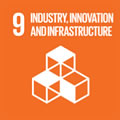Por favor, use este identificador para citar o enlazar a este item:
http://hdl.handle.net/10261/341584COMPARTIR / EXPORTAR:
 SHARE SHARE
 CORE
BASE CORE
BASE
|
|
| Visualizar otros formatos: MARC | Dublin Core | RDF | ORE | MODS | METS | DIDL | DATACITE | |

| Título: | Proactive Effect of Algae-Based Graphene Support on the Oxygen Evolution Reaction Electrocatalytic Activity of NiFe |
Autor: | González-Ingelmo, María CSIC ORCID ; Granda Ferreira, Marcos CSIC ORCID ; Ruiz Bobes, Begoña CSIC ORCID ; Fuente Alonso, Enrique CSIC ORCID ; Sierra, Uriel; Rocha, Victoria G. CSIC ORCID ; González Arias, Zoraida CSIC ORCID ; Álvarez Rodríguez, Patricia CSIC ORCID ; Menéndez López, Rosa María CSIC | Palabras clave: | graphene macro-algae water splitting OER |
Fecha de publicación: | 14-dic-2023 | Editor: | Multidisciplinary Digital Publishing Institute | Citación: | Materials 16(24): 7641 (2023) | Resumen: | The preparation of graphene materials from biomass resources is still a challenge, even more so if they are going to be employed as supports for electrocatalysts for water splitting. Herein, we describe the preparation and characterization of graphene oxides (GOs) from solid macroalgae waste obtained after processing an agar–agar residue. The structural and morphological characterization of the obtained GO confirm the presence of a lamellar material that is composed of few layers with an increased number of heteroatoms (including nitrogen) if compared with those observed in a GO obtained from graphite (reference). Three-dimensional electrodes were prepared from these GOs by depositing them onto a fibrous carbon paper, followed by electrodeposition of the catalyst, NiFe. The electrocatalytic performance of these hybrid systems for the oxygen evolution reaction (OER) showed a proactive effect of both graphene materials toward catalysis. Moreover, the electrode prepared from the algae-based graphene showed the highest electrocatalytic activity. This fact could be explained by the different structure of the algae-based graphene which, due to differences in the nucleation growth patterns and electroactive sites developed during the electrodeposition process, produced more reactive NiFe species (higher oxidation state). | Versión del editor: | https://doi.org/10.3390/ma16247641 | URI: | http://hdl.handle.net/10261/341584 | DOI: | 10.3390/ma16247641 | ISSN: | 1996-1944 | Identificadores: | doi: 10.3390/ma16247641 |
| Aparece en las colecciones: | (INCAR) Artículos |
Ficheros en este ítem:
| Fichero | Descripción | Tamaño | Formato | |
|---|---|---|---|---|
| materials-16-07641.pdf | 9,07 MB | Adobe PDF |  Visualizar/Abrir |
CORE Recommender
SCOPUSTM
Citations
1
checked on 28-abr-2024
Page view(s)
26
checked on 30-abr-2024
Download(s)
21
checked on 30-abr-2024
Google ScholarTM
Check
Altmetric
Altmetric
Este item está licenciado bajo una Licencia Creative Commons



